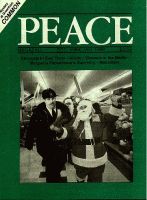
Peace Magazine Dec 1989-Jan 1990, page 5. Some rights reserved.
Search for other articles by various here
The Canadian public may fall into a trap by viewing the war in El Salvador as a "communist" uprising - a view that the U.S. will press us to adopt, now that we have joined the Organization of American States. It would be a big mistake.
The protestors in both Eastern Europe and El Salvador want to change their oppressive regimes. In Europe, they are seemingly able to bring about these changes peacefully. (Gorbachev will not send in tanks.) In El Salvador, the protestors (or rebels, or communists, depending on your viewpoint) are armed and may be destroyed in their bid for power (or freedom, depending on your viewpoint).
In the U.S. view, President Alfredo Cristiani is the legitimate, elected head of the country and the Farabundo Marti National Liberation Front is communist. If that view prevails, we are in for a long civil war, severe repression by the government death squads, and a worsening of the terrible economic conditions. Canada, as a member of the OAS, will have to take sides. Will the FMLN be called "freedom fighters," now that the contras have lost the title?
El Salvador (unlike East Germany) has one of the lowest standards of living. There capitalism wears a white face, buys up all the good land, mines the gold, pays starvation wages, and is backed by government troops and death squads, which in turn are backed by the U.S. military and the CIA. Canadian business has been part of this imposition of outside interests, which killed off the local arts, crafts, and traditional economy.
The old anti-communist blinkers will bring us to disastrous policies. Let's hope Joe Clark and External Affairs will not simply follow the old Monroe Doctrine, yes, the Uncle George line.
Shirley Farlinger, Toronto
We, the Comox Valley Peace Group, are wanting to begin dialogue on the conversion of military bases and spending. If any readers can provide us with information, or sources, or with food for thought, please write to us: Box 3515, Courtenay, B.C., V9N 6Z8
Valerie Sherniff, Courtenay, B.C.
As the survey quoted by Professor Schader in his article "Libraries and Peace" (Aug.Sept.) clearly states, the public libraries are an important means available to enhance citizen self-education concerning nuclear issues. Further, peace and nuclear disarmament issues are of great interest to public libraries.
The obvious step for local peace groups is, as our group did two years ago, to donate a PEACE Magazine subscription, or any other periodicals they feel appropriate, to their local public library. Gifts to public libraries are even tax deductible. From our experience, this is a painless but effective way of helping to create an informed public about peace and nuclear disarmament issues.
Doug Fogel, Coalition for Nuclear Disarmament
When Mr. Phillips writes that "most fields we encounter are too weak to be expected to have any effects," he displays an all-too-common ignorance about biological systems. But he is in good company, because this same ignorance is shared by most spokesmen for power companies and video display terminal manufacturers and users. This point of view would deny vision itself because the electrical and magnetic fields associated with single photons are "too weak to be expected to have any effects." Yet the eye is able to detect signals down to the order of a few, and perhaps even single photons. For a brilliant and authoritative review of how vested interests have tried to cover up biological sensitivity to pulsating electric and magnetic fields, see 3 articles in the June, 1989 issues of the New Yorker magazine by Paul Brodeur.
Brodeur's article also makes it clear that at least with respect to low frequency magnetic fields, standards are a "joke" as I stated, and a bad joke at that. In this case the standards based on heating effects of electromagnetic fields were misapplied to such exquisitely sensitive biological effects as calcium ion transport across cellular and subcellular membranes.
Phillips states that the interview was full of innuendo. Certainly his own letter is not free from it. The interview format does not, of course, lend itself to scientific documentation. Moreover, lay readers are not in a position to access and analyze scientific documentation. By and large they have to rely on "expert" advice. When one enjoys the many fruits of the electrical age, it is comforting for someone with apparent expertise to assure one that fields one encounters "are to weak to be expected to have any effects." "Expected" by whom? Power company spokesmen? VDT manufactures? Heavy users of VDT equipment? Physical scientists ignorant of biological mechanisms? Just as beauty is in the eye of the beholder, assessment of the harmful effects of electromagnetic fields is in the prejudice of the expert passing judgment.
It is tough for readers to know whom to believe. I sympathize and suggest that interested readers pursue Phillip Brodeur's article in the New Yorker magazines before drawing conclusions.
Lynn Trainor, Professor of Physics, University of Toronto

Peace Magazine Dec 1989-Jan 1990, page 5. Some rights reserved.
Search for other articles by various here